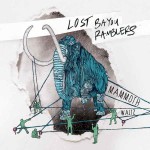Think you know what Cajun music sounds like? Think again.
For the past couple of years, the critical response to live appearances by the Lost Bayou Ramblers at local southwest Louisiana clubs and festivals, as well as far-flung bohemian enclaves like New Orleans’ French Quarter; Austin, Texas; and Brooklyn, New York, has mostly been the stuff of musical intrigue. For those critics eager to capture the unexpected intensity and liberating impulsivity of a live Ramblers’ show, the idea of a punk-rock version of Cajun music has been the most easily available explanation. But as Mammoth Waltz demonstrates, it’s more complicated than that, drawing on roots virtuosity and determined creativity to create a hip, subversive and up-to-date take on the Cajun musical tradition.
Not that the mind-bending statement inherent in Mammoth Waltz comes without anticipation. Last fall, Lost Bayou Ramblers’ Louis Michot released a remarkable compilation, En Français, which highlighted young Cajun and Creole musicians re-inventing classic rock tunes—from Neil Young and the Beatles to Black Sabbath and Joan Jett—as Louisiana French Cajun/Creole performances. Soon after, to mark an ongoing collaboration with former Violent Femmes’ front man Gordon Gano, Michot produced a 12-inch vinyl single with a tune featuring Gano from Mammoth Waltz, “Bastille,” on one side and a remixed version on the other side by the Lafayette rock band GIVERS.
The single provided a heads-up for the sudden, time-traveling experience of Mammoth Waltz, a collection of classics and originals deeply rooted in tradition, recorded first in hard-driving, acoustic-rock performances, then overlaid with a dizzying array of instrumental effects, overdubs, and studio distortions that make use of contributions from a guest list that features Gano, Dr. John, actress/singer Scarlett Johansson, and French actress/singer Nora Arnezeder.
But it’s the symmetrical nature of Mammoth Waltz’s song sequence that hints at an underlying coherence in the Ramblers’ musical approach and this album’s innovations. At its heart are six originals that reflect uniquely Cajun takes on the pleasures of daily life, unavoidable tragedy (in this case, the BP oil spill), and wry, country-based humor. While these tracks are seamlessly stitched together by the presence of Michot’s roots-based vocal wail, they’re also bookended by an in-the-pocket rustic Cajun classic from Nathan Abshire and an obscure classic by Cajun pioneer Joe Falcon. The sequence opens with an obscure 1877 composition that extols the independent Cajun spirit, and it closes with Daniel Lanois’ haunting ballad “O Marie,” which the Ramblers extend to almost seven minutes with an improvised passage that weaves accordion echoes and fiddle screeches together with electronic reverb and washes of digital sound.
Leading the listener peacefully out of this boundary-bashing funhouse is a restructured, remixed reprise of “Coteau Guidry.” It appears twice on the album, the second time with actress/singer Scarlett Johansson’s haunting background vocals repositioned front-and-center.
On Mammoth Waltz, the Lost Bayou Ramblers evoke the late-19th-Century roots of Cajun music and transported the essence of that music to the forefront of 21st-Century popular culture. Given the CD’s sure-handed conception and unerring production, Mammoth Waltz feels like it’s just the opening gambit of what will most likely turn out to be a milestone breakthrough in roots-music cultural alchemy.





